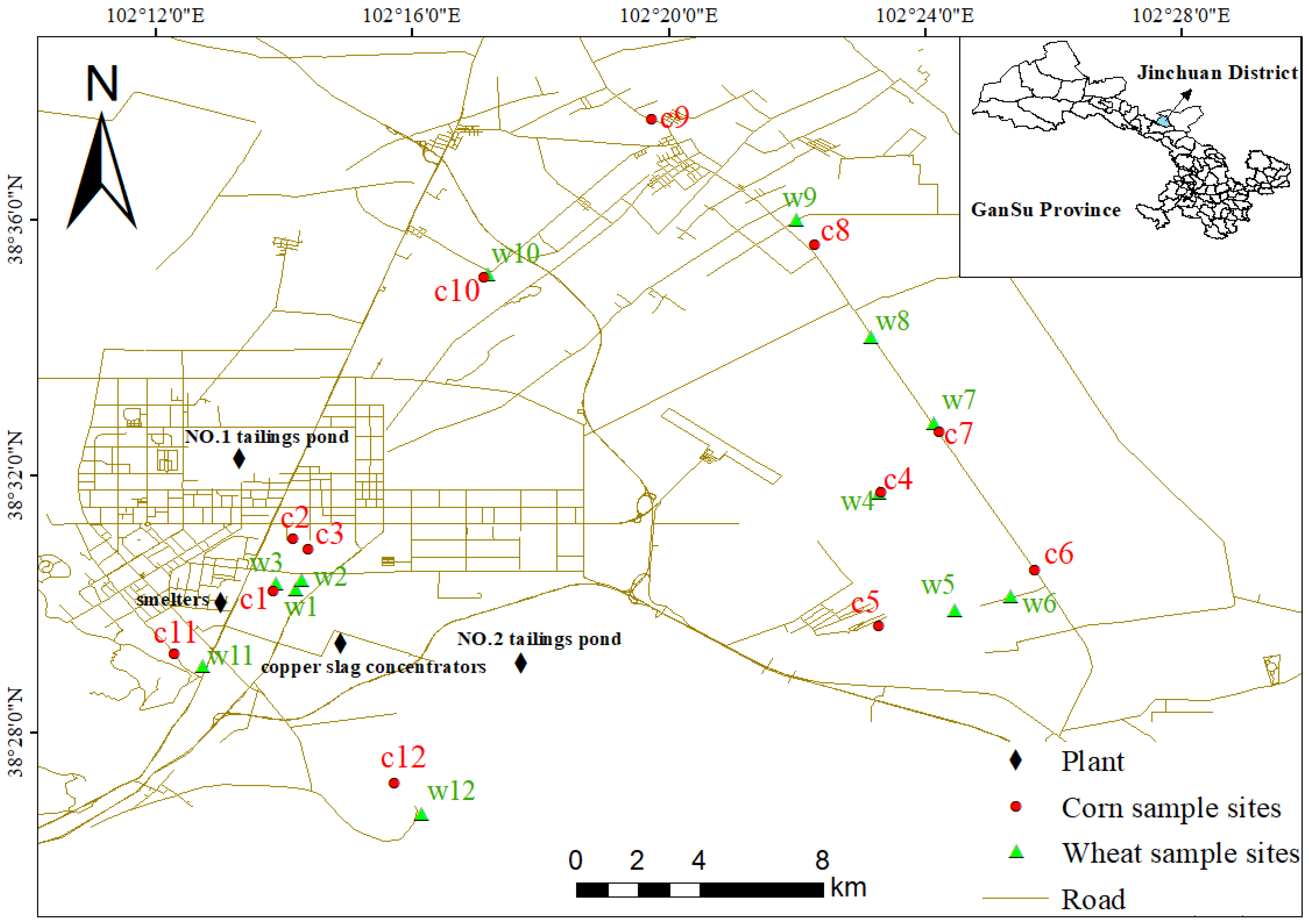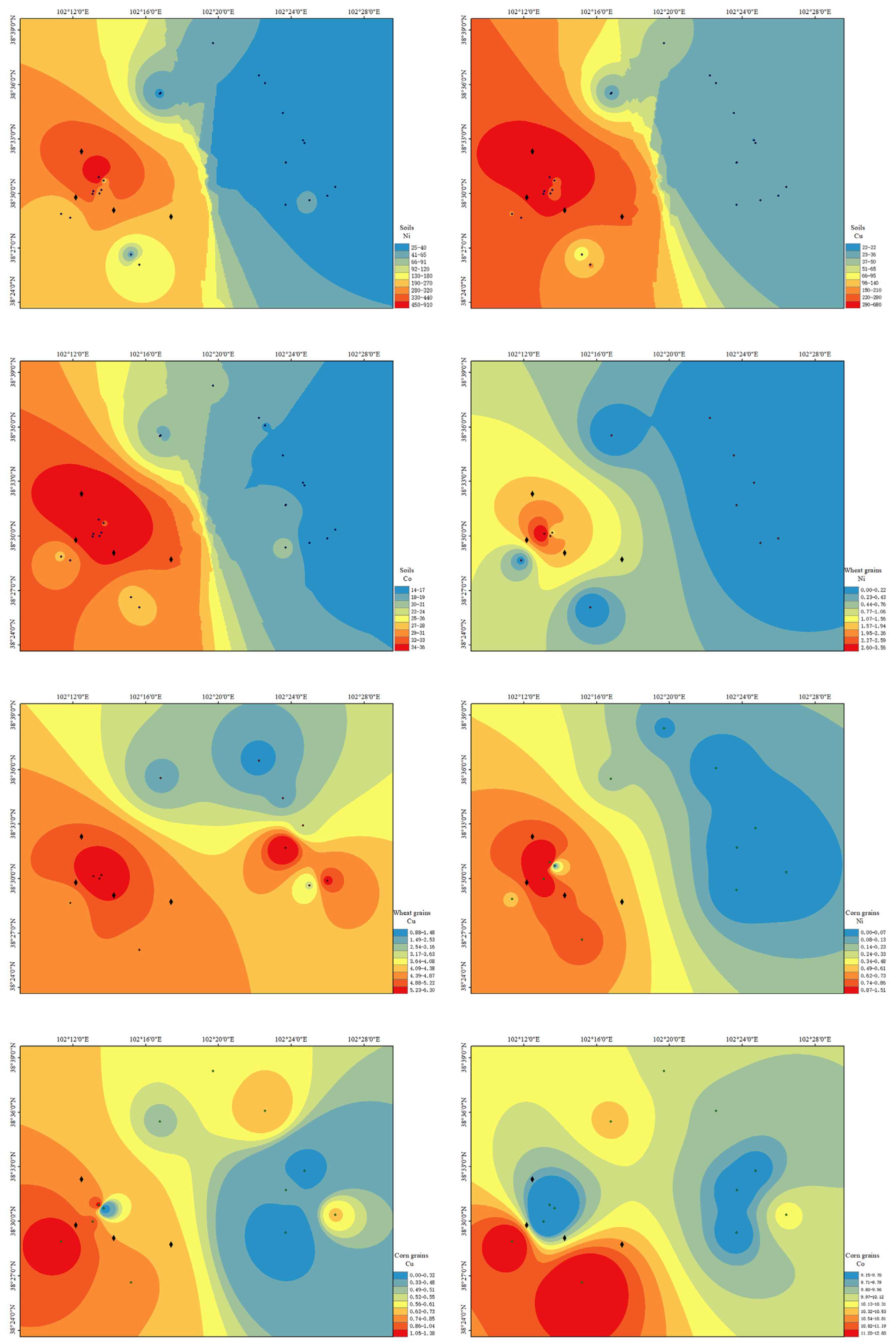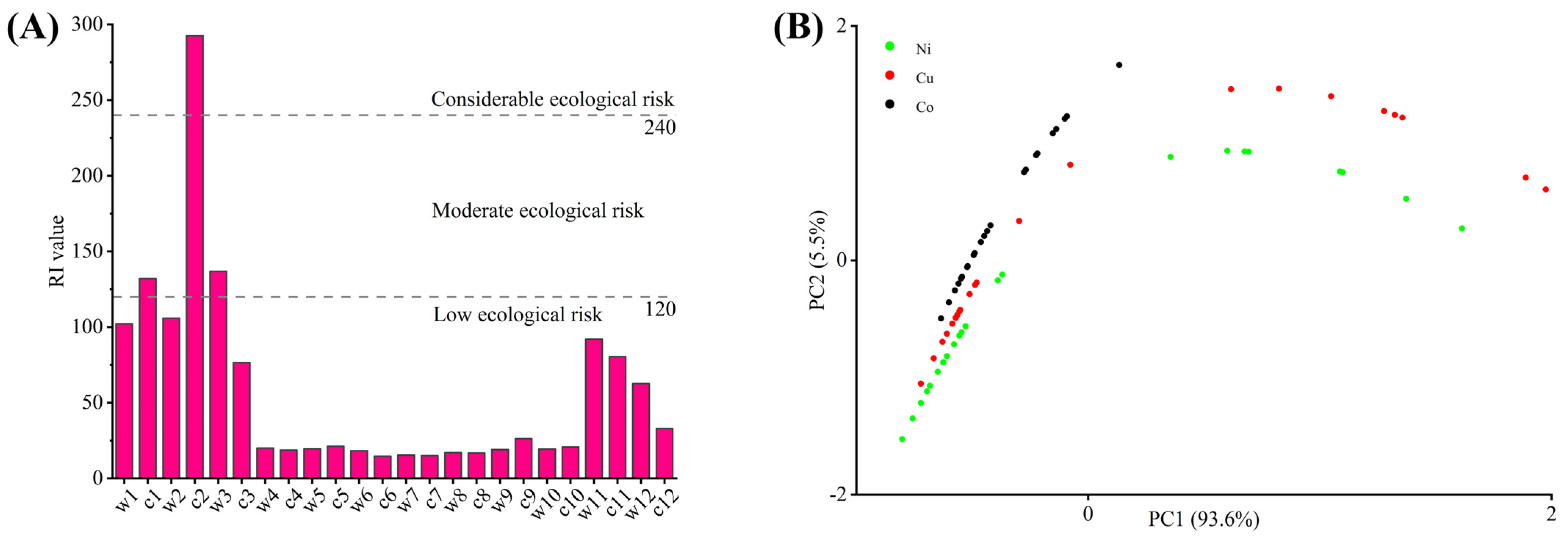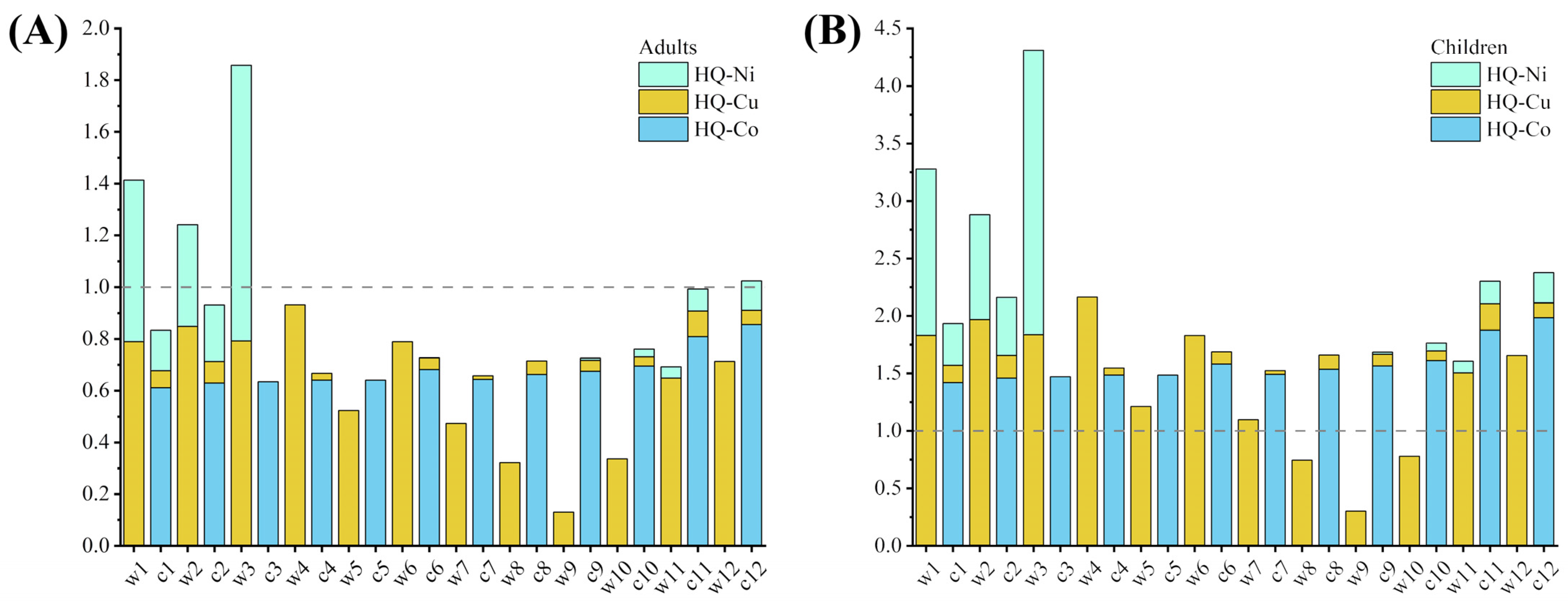3.1. Soil Physicochemical Properties and Heavy Metal Concentrations
Descriptive statistics of soil properties and heavy metal concentrations in the study area are summarized in
Table 1. For wheat-cultivated soils, Ni, Cu, and Co concentrations ranged from 31.65~367.40, 21.50~336.00, and 15.52~36.64 mg kg
−1, respectively, with mean values of 126.69, 118.41, and 23.61 mg kg
−1. Coefficients of variation (CV) for these metals followed the order Cu (96%) > Ni (91%) > Co (35%), where the high CVs for Cu and Ni indicate pronounced influence of local mining and metal smelting activities on soil Cu and Ni concentrations [
28]. In corn-cultivated soils, Ni, Cu, and Co concentrations spanned 25.43~916.10, 24.10~682.00, and 13.70~50.38 mg kg
−1, respectively, with mean concentrations of 160.63, 141.58, and 24.47 mg kg
−1. The CV values exhibited a distinct order: Ni (152%) > Cu (134%) > Co (40%). Notably, Ni and Cu displayed exceptionally high variability (CV > 130%), reflecting extreme site-specific differences in their concentrations, likely attributable to anthropogenic inputs from industrial operations [
29].
Compared to regional background values (
Table 1), the mean concentrations of Ni, Cu, and Co in Jinchuan District significantly exceeded the soil background levels of Gansu Province. In wheat-cultivated soils, mean Ni, Cu, and Co concentrations were 3.60-, 4.91-, and 1.95-fold higher than local background values, respectively. For corn-cultivated soils, these ratios increased, respectively, to 4.56-, 5.87-, and 2.02-fold; this indicates that local soils have been contaminated to varying degrees. Furthermore, the mean heavy metal concentrations in this study surpassed those reported in industrially impacted regions such as Sargodha, eastern Pakistan [
14], and Guilin City, Guangxi Province, China [
30]. Notably, Ni concentrations at sampling sites w8, c6, c7, c8, and c10 were lower than the regional background value, likely due to their greater distance from smelting facilities and reduced industrial influence. According to
Table 1, 29.17% of sampling sites exceeded China’s risk screening values for Ni, while 37.50% surpassed the Cu threshold, suggesting potential risks to agricultural product safety. These anomalies are attributable to decades of intensive mining and metallurgical activities in the region. Previous work by Batool et al. [
14] reported that in a suburban agricultural town of eastern Pakistan, prolonged wastewater irrigation has resulted in cadmium (Cd) accumulation in locally grown wheat exceeding safety thresholds, posing potential health risks to consumers. Studies by Lv et al. [
17] identified metal smelting activities as the primary cause of heavy metal contamination in soils surrounding manganese mining areas in Hunan Province, China. Sierozem soils, characterized by organic matter and calcium carbonate content, can immobilize toxic heavy metals through adsorption, limiting their environmental mobility [
31]. For instance, in karst soils of southwestern China, Cu predominantly binds to organic matter and carbonate phases, whereas Ni is primarily sequestered in goethite mineral matrices [
32,
33].
Soil analysis (
Table 1) revealed weakly alkaline conditions in the study area, with pH ranging from 7.83 to 8.23. Low electrical conductivity (EC) and organic matter (OM) levels aligned with typical sierozem characteristics. The cation exchange capacity (CEC), reflecting soil nutrient retention potential, ranged from 0.12 to 12.11 cmol
+ kg
−1 (mean: 4.46 cmol
+ kg
−1), indicating moderate fertility retention capacity. Heavy metal enrichment in soils is influenced by multiple factors, including geogenic background, pedogenic processes, and anthropogenic activities [
34,
35]. Correlation analyses (
Table 2) were conducted to explore relationships among Ni, Cu, Co, pH, EC, OM, and CEC. Pearson correlation coefficients (
Table 2) showed significant positive correlations (
p < 0.01) among Ni, Cu, and Co in agricultural soils, suggesting shared anthropogenic origins and potential synergistic contamination effects. In wheat-cultivated soils, Ni, Cu, and Co exhibited positive correlations with OM (
p < 0.05), indicating co-accumulation with organic matter. Conversely, no such trend was observed in corn soils. These divergent patterns align with findings by Lasota et al. [
6], who reported that correlations between heavy metals and OM may vary across soil datasets. Humic substances in Silesia, Poland, can stabilize heavy metals via metal–organic ligand complexation, potentially explaining the OM-dependent accumulation in wheat soils [
6]. Ni and Co in wheat soils showed strong positive correlations with CEC (
p < 0.01), while Cu correlated moderately (
p < 0.05). This phenomenon is likely attributable to the greater abundance of negatively charged sites on soil particles at higher CEC levels, which strengthens their adsorption capacity for heavy metals [
36]. In corn soils, EC and pH displayed a significant negative correlation (
p < 0.01), likely driven by reduced soluble salt content in high-pH soils, which lowers ionic conductivity [
37].
3.2. Spatial Distribution of Heavy Metals in Soils and Crop Grains
Compared to other spatial interpolation methods, the inverse distance weighting (IDW) method more accurately predicts maximum and minimum values and provides better boundary details [
38].
Figure 2 displays the spatial distribution maps of heavy metals in soils and crop grains generated using the IDW method. Co in wheat grains was not analyzed due to undetectable levels.
Figure 2 shows that the spatial distribution trends of Ni, Cu, and Co in soils were similar, indicating shared sources of heavy metals, consistent with the correlation analysis results. The most severely contaminated soil sampling sites were located near the smelting plant. Based on the prevailing wind direction, the severe heavy metal contamination in soils northwest and southeast of the mining area was likely caused by dust deposition from tailings ponds under wind transport. Other sampling sites, farther from mining activities, showed lesser impacts. In agricultural soils of Anxin County, Hebei Province, the primary sources of Cd, Pb, Zn, and Cu contamination are industrial activities and mobile sources, demonstrating that heavy metals disperse from sources to surrounding areas under human influence [
35]. Studies by Anaman et al. [
39]. and Xu et al. [
40]. highlighted transportation and atmospheric deposition as major factors affecting heavy metal distribution. The spatial distribution results confirm that local metal smelting activities dominate heavy metal contamination.
The spatial distribution of heavy metals in crop grains revealed that Ni distribution in grains closely resembled that in soils, while Cu and Co distributions differed significantly, suggesting soil Ni concentrations can predict grain Ni levels. For wheat grains, Cu hotspots were concentrated near the smelting plant and extended eastward, whereas corn grains showed Cu hotspots near the smelting plant and northeastward, with Co hotspots located south of the plant. The heavy metal content in wheat and corn grains is influenced by soil physicochemical properties, metal speciation, soil microbes and minerals, and crop root exudates [
41], which likely explain the spatial discrepancies in Cu and Co distributions between grains and soils.
To further elucidate factors influencing heavy metal translocation from soils to wheat and corn grains, a correlation analysis was conducted between heavy metal concentrations in grains, soils, and soil properties (
Table 3). First, Ni and Cu in corn grains showed a significant positive correlation (
p < 0.01), suggesting shared origins. Notably, while Ni is toxic, Cu is an essential micronutrient for corn, implying potential overlap in their uptake or transport regulatory pathways [
42]. This contrasts with findings by Pekel et al. [
43], who reported no Ni-Cu correlation in corn grains, possibly due to varietal differences in metal absorption [
10,
44]. Second, Ni in grains correlated strongly with soil Ni, Cu, and Co (
p < 0.01), indicating that elevated soil metal levels enhance Ni accumulation in grains, consistent with spatial distribution predictions. Conversely, grain Cu and Co showed no significant correlations with soil metals (Ni, Cu, Co), aligning with results from Wu et al. [
45], which may reflect sub-threshold soil metal concentrations for phytotoxicity. According to Deng et al. [
46], Ni and Co undergo continuous translocation between phloem and xylem, ultimately redistributing via phloem to plant tissues. Third, Ni in wheat grains correlated significantly with soil OM (
p < 0.05) and CEC (
p < 0.01), suggesting that organic chelators in soil enhance Ni bioavailability and plant uptake [
47]. While Cu in grains and Co in corn grains showed no significant links to soil properties, the relationship between grain metals and bioavailable soil fractions warrants further exploration.
3.3. BCFs of Ni, Cu and Co
Table 4 presents the mean bioconcentration factor (BCF) values across different tissues of wheat and maize plants. For wheat plants, the average BCFs of Ni, Cu, and Co followed the order: leaves > roots > husks > stems > grains, roots > leaves > grains > husks > stems and roots > leaves > stems > husks > grains, respectively. In corn plants, the orders were, respectively, leaves > roots > stems > husks > grains (Ni), leaves > roots > stems > husks > grains (Cu) and grains > husks > leaves > stems > roots (Co). BCF values indicated higher accumulation of Ni and Cu in roots and leaves compared to other tissues. Podar and Maathuis [
48] reported that cereals inherently restrict heavy metal translocation from roots to edible aerial parts. Liu et al. [
49] demonstrated that atmospheric heavy metals can infiltrate plants via foliar uptake. In this study, elevated Co levels in corn grains may stem from atmospheric dust deposition, with taller corn plants being more susceptible to airborne contamination. Studies by Ma et al. [
50] and Xu et al. [
19] consistently demonstrate that plant roots serve as the primary site of heavy metal accumulation. This may be attributed to the immobilization of heavy metals through chelation by root cell walls, which restricts their entry into the cytoplasm, or the presence of the Casparian strip that further impedes metal translocation [
41].
As shown in
Table 4, the BCFs of Ni, Cu, and Co in wheat roots were 1.46-, 2.24-, and 5.77-fold higher than those in corn roots, respectively, indicating that wheat is more susceptible to heavy metal contamination. Similar conclusions were reported by Wu et al. [
16] and Xue et al. [
51] in agricultural regions of Henan and Hebei Provinces, China, suggesting that wheat exhibits greater sensitivity to heavy metal stress than corn, posing higher health risks to humans. Rezapour et al. [
52] demonstrated that wheat exhibits stronger translocation of heavy metals from soil to roots than from roots to grains. In contrast, Romdhane et al. [
53] found that corn preferentially transfers heavy metals to stems and leaves. To assess the safety of locally produced crop straw as livestock feed, mean heavy metal concentrations in wheat and corn tissues are presented in
Table 5. Results indicated that, according to the Safety Guidelines for Feed Additives, Co concentrations in all wheat and corn tissues exceeded regulatory limits except for wheat grains and corn roots/stems. Similarly, Cu concentrations in wheat roots, corn leaves, and wheat leaves surpassed permissible thresholds, confirming that straw from these crops is unsuitable for use as standalone animal feed.
3.4. Soil Pollution and Health Risk Assessment
Table 6 summarizes the percentages of sampling sites classified under different geo-accumulation index (
Igeo) and single-element potential ecological risk index (
Eri) levels. According to
Igeo criteria, 21% and 37% of sampling sites for Ni and Cu, respectively, exhibited contamination levels of moderately heavy pollution or higher, with 4% of sites for both metals reaching extreme pollution, indicating significant accumulation of Ni and Cu in regional soils. All Co-contaminated sites were classified as moderate pollution or lower. For
Eri, 12% (Ni) and 29% (Cu) of sampling sites posed moderate ecological risk or higher, with 4% of sites for both metals categorized as considerable ecological risk, suggesting potential threats to human health via food chain accumulation. Co-associated risks remained low across all sites. Overall, the descending order of contamination and ecological risk levels for all metals was: Cu > Ni > Co.
As shown in
Table 6, the three elements in soils were significantly altered by production activities from mining enterprises near farmland, leading to severe spatial heterogeneity in heavy metal distribution. The potential ecological risk (RI) assessment (
Figure 3A) revealed the highest ecological risk at sampling site c2, classified as considerable ecological risk, followed by c1 and w3 with moderate ecological risk, all located near local mining areas. Sites adjacent to mining zones (w1, w2, c3, w11, c11, w12, c12) exhibited elevated RI values within the low ecological risk category, further confirming mining activities as the primary contamination source. Elevated risks at other sites likely stem from persistent dust deposition linked to metal smelting and vehicular emissions [
4]. Given the irreversible ecological impacts of heavy metal pollution in agricultural soils, immediate remediation measures are urgently required for this region.
To better understand contamination characteristics,
Igeo,
Eri and total heavy metal concentrations in soils were incorporated into principal component analysis (PCA). As shown in
Figure 3B, two principal components were extracted: PC1, dominated by
Eri and total metal concentrations, explained 93.6% of the total variance, while PC2, driven by
Igeo values, accounted for 5.5%. Based on
Figure 3B, the
Igeo levels approximately ranked as Co > Cu > Ni, indicating multi-metal composite pollution with high similarity among the three metals, being consistent with spatial distribution predictions. The PCA results suggest that spatial heterogeneity of heavy metal concentrations is the primary factor influencing contamination patterns. The high explanatory power of PC1 underscores anthropogenic interventions, particularly mining and smelting activities, as key drivers of heavy metal distribution across the study area.
Wheat and corn, as staple crops in Jinchuan District, Jinchang City, are closely linked to the health of local residents.
Table 7 presents the chronic daily intake (
CDI) of heavy metals for adults and children. Most studies indicated that children face higher non-carcinogenic risks from heavy metals in grains compared to adults [
5,
54]. In this study, wheat was identified as the primary source of Ni and Cu exposure, while Co exposure predominantly originated from corn. The
CDI values for children were 2.32-fold higher than those for adults. The non-carcinogenic hazard index (
HI) results are shown in
Figure 4.
HI values in this study revealed that children in Jinchuan District face greater non-carcinogenic health risks than adults, with the highest risk observed for wheat from site w3 (
HI = 4.309), followed by w1 (3.279) and w2 (2.881). Notably, 16.67% of adults and 87.50% of children in the study area were exposed to non-carcinogenic health risks. Approximately 75% of children exhibited hazard quotients (
HQ) > 1 for Cu in wheat, while all children showed
HQ > 1 for Co in corn, indicating that Cu in wheat and Co in corn are the primary contributors to
HI among the three heavy metals. Health risk assessments indicate that children face greater harm, likely due to their lower body weight and higher metabolic rates [
55]. Furthermore, long-term heavy metal exposure may cause irreversible impairments to neurological and immune systems in children [
11]—an urgent public health priority requiring immediate attention.
For individuals living near metal smelting zones, heavy metals can also enter the human body through inhalation and dermal contact, potentially leading to higher non-carcinogenic health risks [
56]. Based on this study, the following recommendations are proposed for local agricultural practices: In areas corresponding to sampling sites c8, c9, and c10, corn cultivation poses health risks exceeding safety thresholds, while wheat cultivation presents lower risks. Therefore, replacing corn with wheat or alternative crops in these regions is advised to reduce heavy metal exposure for residents. Other sampling sites are no longer suitable for growing wheat or corn intended for human consumption, and soil remediation measures should be implemented in these farmlands.










